“CHURCH’S COSMOS” BY
ELEANOR JONES HARVEY
Of all the American artists inspired by Alexander von Humboldt, Frederic Edwin Church was perhaps the most astute in his blending of art and science in the service of landscape painting that was simultaneously topographically accurate and aesthetically stimulating. In the second volume of his Cosmos, Humboldt might well have been speaking directly to Church when he wrote, “Landscape painting, though not simply an imitative art, has a more material origin and a more earthly limitation. It requires for its development a large number of various and direct impressions which, when received from external contemplation must be fertilized by the powers of the mind, in order to be given back to the sense as a fine work of art. The grander style of heroic painting is the combined result of a profound appreciation of nature and of this inward process of the mind.”
Church had heard similar words from his artistic mentor, the painter Thomas Cole, who had called for a “higher style of landscape,” urging artists and patrons alike to embrace the idea that landscape painting should place naturalistic accuracy in the service of a greater idea. Cole’s was an influential voice asserting that landscape painting carried moral and cultural significance for Americans. In the second volume of Cosmos, Humboldt described the relationship between nature and the human mind as one that carries us “beyond the mysterious boundary which connects the metaphysical with the physical, and leads us into another and higher sphere of ideas.” In the third volume, he affirmed that in art, one needs to paint not only what he called “the pure objectiveness of external phenomena,” but also a “reflection of the image impressed by the sense upon the inner man, that is, upon his ideas and feelings.” Humboldt’s philosophical approach reinforced the power of the fine arts to engage in the sphere of profound ideas, encompassing spiritual and metaphorical levels of meaning in what was also a geologically inspired landscape painting.
During his tutelage under Cole from 1844 to 1846, Church relished sketching out of doors in pencil and in oil, earning Cole’s respect for his acute observations and artistic skill. Cole once remarked that his student had “the finest eye for drawing in the world.” In the field, Church delighted in recording botanical details in his sketches, embellished his cloud studies and sunsets with elaborate penciled color notes, and used his forays into nature to feed his Humboldtian curiosity for the world of nature. In the studio, he synthesized his sketches into monumental compositions that were at once natural and constructed, blending close observation with an eye to larger truths about man’s relationship to nature.
Church’s introduction to Humboldt came early, part of the contemporary wave of enthusiasm for the Prussian naturalist’s writings. In addition to owning multiple volumes of Cosmos, Church owned English translations of the first two volumes of Humboldt’s Personal Narrative of a Journey to the Equinoctial Regions of the New Continent (seven volumes were published between 1814 and 1829) and two copies of his Aspects of Nature (1849). In each of these books, Church was exhorted to open his eyes and see both the welter of detail and the big picture into which it fit, a novel but exhilarating concept for the young artist. Humboldt’s soaring prose spurred the Hartford native to take two trips to South America, each time traveling in the Prussian’s footsteps.
Church surrounded himself with friends and patrons who shared his appreciation for Humboldt’s view of nature. Cyrus Field, who would lay the first transatlantic cable (and send Humboldt a segment of it as a souvenir), accompanied Church on two of his sketching trips — the first to Natural Bridge, a geologic formation in Virginia in 1851, and then, two years later, on the first of the artist’s two trips to South America. At Field’s request, Church painted The Natural Bridge, Virginia in 1852. On site, Church had made pencil sketches, annotating them with color notes to guide him back in the studio. Field pocketed several rocks, offering to let Church refer to them as he painted the arch, but the artist demurred. According to Field’s daughter, when her father beheld the completed painting, he pulled the rocks out of his pocket and proclaimed that they matched the hues in Church’s painting. Like Giotto’s perfect circle drawn freehand on a wall, Church’s flawless color memory became a hallmark of his reputation and proof of the acuteness of his vision in the field.
Church and Field were both steeped in Humboldt’s writings. In 1853, the pair spent close to seven months retracing the scientist’s journey across Colombia and Ecuador, hiring local guides and staying in some of the same lodgings in an effort to channel Humboldt’s way of thinking about geology, botany, and man’s impact on his environment. Humboldt’s narratives served as Church’s Baedeker, and the artist’s journals and sketches provide ample evidence of his interest in following the great naturalist’s footsteps. Church’s sketches in oil and in pencil, along with his journals, provide a window into the artist’s keen appreciation for Humboldt’s observations.
Church did not confine his growing interest in learning the natural world to South America. In April 1857, he debuted his first “Great Picture” — Niagara — to wide acclaim. With its panoramic composition and riveting representation of water in motion, Niagara was unlike any other American landscape painting. The reviewer in the Home Journal proclaimed, “If the object of painting be to render faithfully, and yet poetically, what an artist’s eye discerns, this is Niagara, with the roar left out!” As Church’s painting began its triumphal tour across America and to London, the artist embarked on his second trip to South America, this time with fellow artist Louis Rémy Mignot. This four-month foray was intended to reacquaint Church with key features in Humboldt’s narratives, notably the explorer’s favorite volcano, Chimborazo.

Frederic Church, Study for “The Heart of the Andes,” 1858, oil on canvas, 10¼ x 18¼ in., Olana Collection, OL.1981.47
Upon his return, Church let it be known publicly that he intended to outdo his earlier efforts and surpass Niagara in scale, scope, size, and attendant drama. In April 1859, he orchestrated the display in New York City of The Heart of the Andes, a colossal painting that appeared even larger thanks to an elaborate frame designed to resemble a window casement; parted draperies intensified that illusion. Church made extensive use of sketches he had made on his two trips to compose the picture, the superabundance of plants and birds in the foreground paying dual homage to Humboldt’s advice to artists and his passion for studying every possible feature in nature.
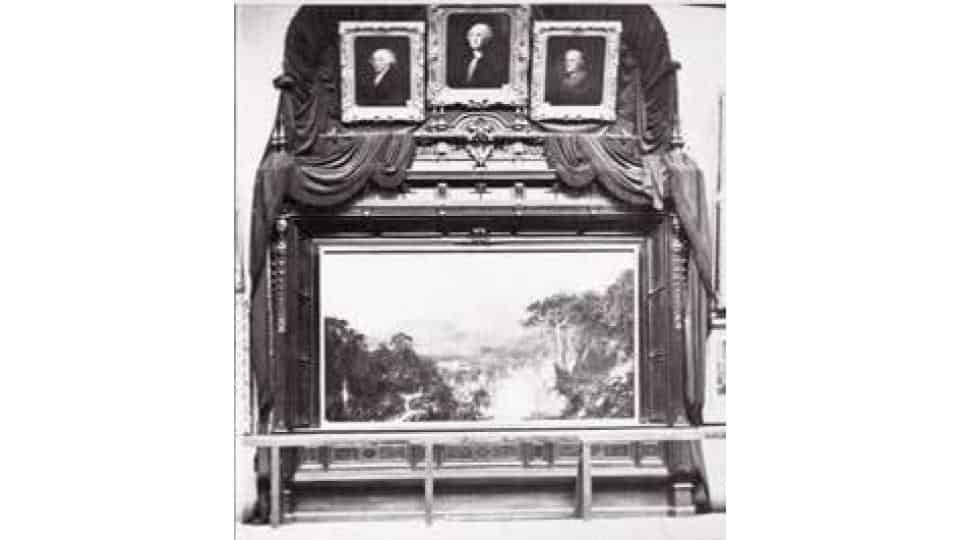
Unidentified photographer, “The Heart of the Andes,” by Frederic Church, as exhibited at the Metropolitan Sanitary Fair, 1864, stereograph (one side), The New-York Historical Society Manuscripts Collection, negative number 61263
Alexander von Humboldt died that same year and never saw The Heart of the Andes, but Church’s interest in the naturalist did not diminish. Later, in the summer of 1859, he traveled to Labrador to sketch icebergs; in preparation for the trip, the artist had read extensively on the physical and optical properties of ice, to understand better what he would be seeing and painting. Humboldt’s eagerness to explore, see, and learn from nature guided Church’s own studies, and each of the artist’s subsequent Great Pictures would embody aspects of the Prussian’s ideas.
Humboldt’s posthumous influence on American arts and science remained strong as well. Church was a member of the American Geographical and Statistical Society in New York, a group of scientists, artists, and literary men who shared a fascination with the natural world, inspired in large part by the popularity of Humboldt’s writings. Another of its members was Dr. Isaac Israel Hayes, who had been the medical officer aboard Elisha Kent Kane’s celebrated 1854 voyage in search of the British explorer Sir John Franklin. Franklin’s two ships, the Erebus and the Terror, were declared lost in 1848 while seeking the Northwest Passage, triggering nearly fifty years of Arctic exploration in search of the missing ships and crew. Church and Hayes had become friends by 1860, each man developing an interest in the other’s profession, to the extent that Church coached Hayes with drawing lessons, and used several of the explorer’s sketches while composing Aurora Borealis (in the Smithsonian American Art Museum). The two men were also founding members of the Travellers Club, a group of 25 scientists, artists, writers, and businessmen established in 1864. In December that year, Church hosted a gathering of the Travellers Club in his studio to see Aurora Borealis before its formal debut. Church wrote to Hayes expressing his hope that the explorer would attend to see the painting he had based largely on the latter’s sketches and stories.
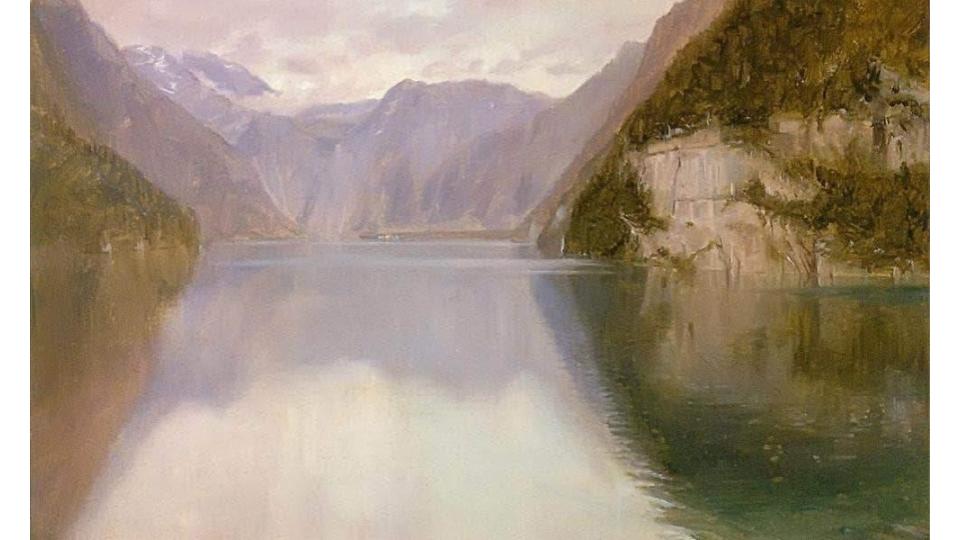
Frederic Church, ‘Königssee, Germany,’ July 1868, oil on paper mounted on canvas, 13 X 20 in., Olana Collection, OL.1981.42
In 1868, when Church made his only trip to Europe, he skipped over much of the traditional Grand Tour in his eagerness to reach Greece and Palestine. But even there he kept Humboldt in mind, noting, as he sketched in Germany and Austria, that the area around Salzburg and Königssee were spots the naturalist had declared the most beautiful. On his ten-day camel trip to Petra, Church sketched the bizarre rock formations and rock tombs. Everywhere Church went, he demonstrated a sharp eye for his surroundings. During the 1870s, after he built the main house at Olana, Church displayed his finished oil sketches and paintings throughout his dwelling, documenting the span of his career and his interests. From New England to South America, Europe and the Middle East, the places depicted in these works of art spoke to the breadth and depth of Church’s interests in travel as a means of seeing and comprehending the world. Olana became far more than just a home — it developed into a means by which Church surrounded himself with ideas and memories reminiscent of the range of interests found in Humboldt’s books. As the century drew to a close, the pace of scientific discovery seemed to increase. The differentiation of what Humboldt had known as Natural Philosophy into myriad separate scientific disciplines made it impossible for any one person to keep up with all of the developments. In 1883, Church wrote in frustration, “I wish science would take a holiday for ten years so I could catch up.”
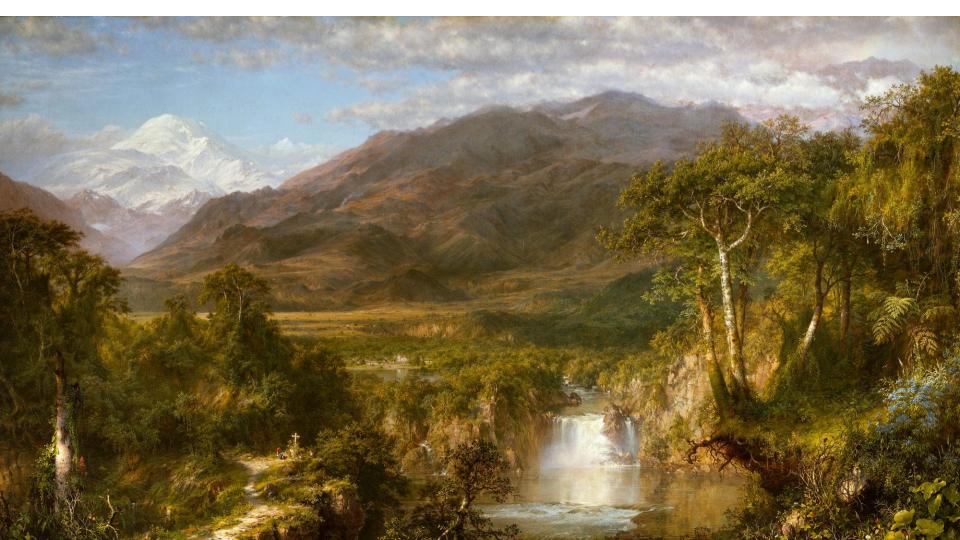
Frederic Church, ‘The Heart of the Andes,’ 1859, oil on canvas, 66 1/8 x 119 ¼ in., The Metropolitan Museum of Art, Bequest of Margaret E. Dows, 1909. (.09-95), Photograph ©The Metropolitan Museum of Art
Church and Humboldt shared an appreciation for travel as a means of sharpening perceptions and developing insights, whether scientific or artistic. In his copy of Humboldt’s second volume of Cosmos, Church highlighted a passage reading, “The azure of the sky, the form of the clouds, the vapoury mist resting in the distance, the luxuriant development of plants, the beauty of the foliage, and the outline of the mountains, are the elements which determine the total impression produced by the aspect of any particular region. To apprehend these characteristics, and to reproduce them visibly, is the province of landscape painting; while it is permitted to the artist, by analysing the various groups, to resolve beneath his touch the great enchantment of nature — if I may venture out on so metaphorical an expression — as the written words of men are resolved into a few simple characters.” Church did not often annotate or otherwise mark up his books, suggesting that this passage carried particular meaning for the artist. Humboldt’s affirmation — that as a poet distilled universal meaning in a few phrases, so the landscape painter was enjoined to present the essence of nature drawn from her myriad forms — aligned with Church’s approach to his art. Humboldt’s concept of the interrelatedness of nature, grounded in the synthesis of art and science, found its nearest artistic equivalent in the sketches and paintings of Frederic Edwin Church.
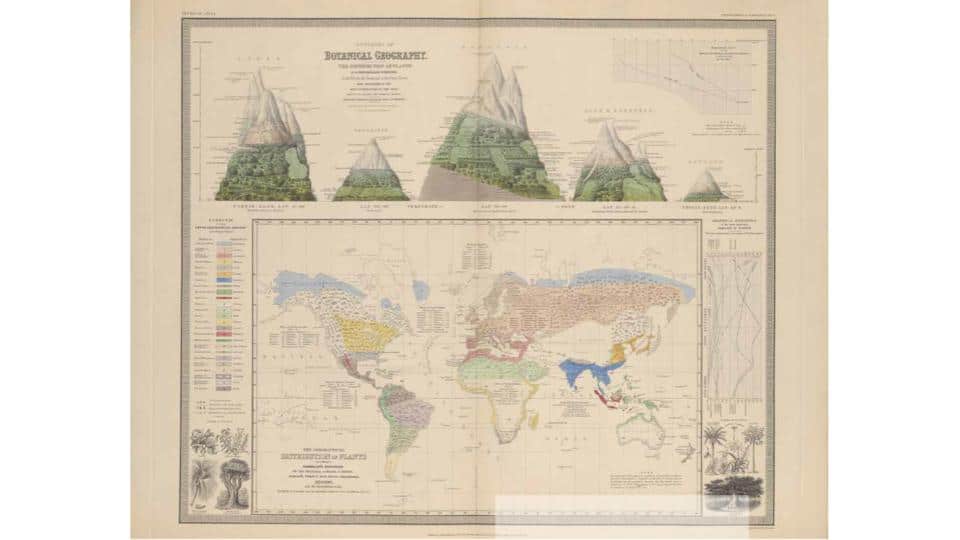
‘“Naturgemälde” from Essay on the Geography of Plants, Accompanied by a Physical Table if the Equinoctial Regions,’ engraving by with watercolor by Louis Bouquet, drawing by Lorenz Schönberger and Pierre Turpin, 1805, after a sketch by Alexander von Humboldt (Paris: Levreault, Schoell and Co., 1805), 14 9/16 x 31 11/16 in., University of Zurich Central Library
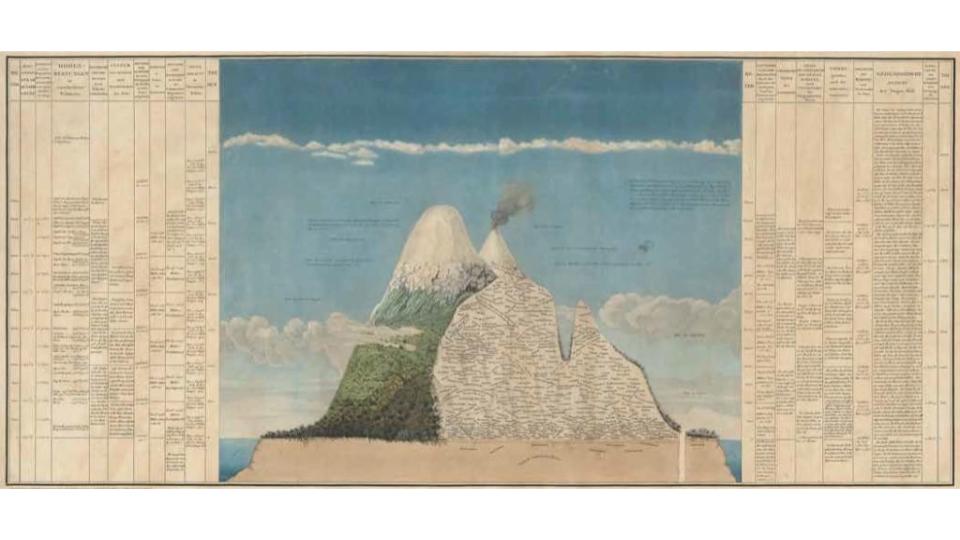
‘Outlines of Botanical Geography: The Distribution of Plants in Perpendicular Directions, in the Torrid, Temperate and the Frigid Zones; with Indications of the Mean Temperature of the Year and of the Coldest and Warmest Months,’ 1845, after a sketch by Alexander von Humboldt, illustrated in Heinrich Berghaus, Physikalischer Atlas (Gotha, 1838–1848), volume V, plate no. 1, Wellcome Library Collection, UK

